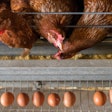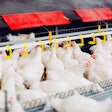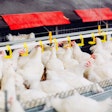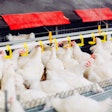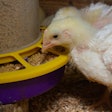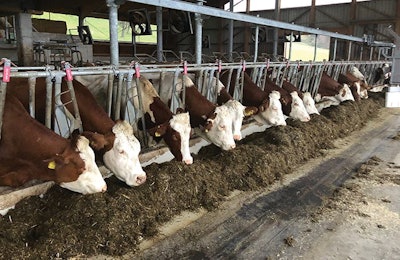
Feed additives are defined as products used in animal nutrition for improving the quality of feed or the animals’ performance and health. They may be classified as technological, sensory, nutritional, or zootechnical additives.
The objective of this article is to summarize six recent research studies focused on feed additives used in dairy cow diets.
- Encapsulating potassium carbonate to reduce its chemical reactivity
Potassium carbonate is a feed additive used as a source of potassium in dairy diets; however, in the presence of moisture, this reacts to cause the heating of the total mixed ration and palatability issues.
Researchers from South Dakota State University evaluated whether feeding a free fatty acid (FFA)-encapsulated potassium carbonate would create palatability issues in lactating dairy cows when compared with feeding potassium carbonate sesquihydrate, a less reactive source of potassium carbonate.
Cows were fed either 68 g/day of potassium carbonate sesquihydrate plus 204 g/day of bypass fat as individual ingredients or 272 g/d of FFA-encapsulated potassium carbonate. The findings, published in The Professional Animal Scientist, showed no differences in dry matter intake between diets for either consumption within the first 10 minutes after feeding or the daily ad libitum intake.
In conclusion, the authors suggested there was no palatability issue with the FFA-encapsulated potassium when fed to lactating dairy cows.
- Efficacy of using exogenous fibrolytic enzymes to improve performance
A meta-analysis on the effect of dietary application of exogenous fibrolytic enzymes (EFE) on the performance of dairy cows was published recently in the Journal of Dairy Science. University of Florida researchers included in the meta-analysis 15 peer-review studies with 17 experiments and a total of 36 comparisons. The most commonly used EFE was cellulase-xylanase complex (13 studies).
Overall, across all studies, feeding EFE did not affect dry matter intake nor feed efficiency but tended to increase dry matter and fiber digestibility by relatively small amounts (1.36 and 2.30 percent, respectively). Application of EFE increased lightly yields of milk (1.9 lbs./day), 3.5 percent fat-corrected milk (1.2 lbs./d), and milk protein (0.07 lbs./d).
Surprisingly, increasing the rate of application of EFE did not affect performance results.
- Balancing for amino acids, does it improve profits?
A study published in The Professional Animal Scientist journal showed the effects of balancing lactating cow diets for amino acids on the profitability of a commercial dairy in Washington. The authors conducted three experiments (two in multiparous and one primiparous cows) in which compared current diets (~17.6 percent protein) with reformulated diets intended to reduce feed cost and dietary protein concentration (15.9−17.6 percent) containing a high-quality rumen undegradable protein source and rumen-protected amino acids (lysine and methionine).
The prices ($/lb) of milk fluid, protein, fat, and solids of the grade A milk in Washington state were 0.009, 2.889, 1.624, and 0.443 in 2013, respectively, and 0.017, 3.22, 2.36, and 0.479 in 2014. When cows were fed the balanced amino acid diets, income over feed cost was consistently greater than the control diets in first lactation cows ($0.15 - 0.18 cow/day) but consistently lower in multiparous cows ($0.08 - 1.01 cow/day).
- Added fat and fiber digestibility
It has been reported dietary fat affects significantly total-tract fiber (NDF) digestibility in lactating dairy cows. A meta-analysis published in the Journal of Dairy Science showed the effects of supplemental fat on fiber digestibility. The data set included 108 fat-supplemented lactating cow diets from 38 publications in which fiber digestibility averaged 49.4 percent (± 9.3 standard deviation).
The authors, from the University of Wisconsin-Madison, classified the fat sources in eight categories: medium-chain fatty acids (12- and 14-carbons), unsaturated vegetable oil, palmitic acid, tallow, animal-vegetable fat, calcium salts of palm oil, calcium salts of long-chain fatty acids, and saturated fat.
In summary, while medium-chain fatty acid (12- and 14-carbons) and unsaturated vegetable oil both significantly decreased fiber digestibility (2.7 and 0.6 percentage units/1 percent fatty acids, respectively), calcium salts of long-chain fatty acids and saturated fats increased fiber digestibility (1.1 and 0.4 percentage units/1 percent FA, respectively). The other fat supplements did not affect fiber digestibility.
- Flavors, do they stimulate intake in?
Using a cafeteria-design experiment, researchers from The Pennsylvania State University evaluated whether dairy cows have flavor preferences. Cows were offered seven flavored concentrate premixes (anise, fenugreek, honey, orange, thyme, molasses, and vanilla) and one control premix with no flavor added. The inclusion rate of the flavors in the concentrates was 250 to 300 grams per ton.
The findings, published in the Journal of Dairy Science, showed relative to the control, concentrate intake was not affected by flavor. However, among flavored concentrates, the vanilla and fenugreek concentrates were consumed the most, whereas the orange and anise were consumed the least.
- Selenium-fertilized forages: viable way of supplementing dairy cows?
Canadian researchers compared the effect of selenium-fertilized forages to dietary sources of inorganic and organic selenium. The selenium-fertilized forages were pure timothy and a mix of alfalfa/timothy produced at the Centre de Recherche en Sciences Animales de Deschambault, Quebec, by fertilizing with a slow-release selenium fertilizer containing 10 g of selenium/kg applied at a rate of 25 g of selenium/ha.
Selenium concentrations in the selenium-fertilized timothy and alfalfa mix were 25 (1.49 versus 0.06 mg/kg of dry matter) and 39 times greater (0.05 vs. 1.97) than concentrations in non-fertilized forages, respectively. The results of this study indicated selenium from selenium-fertilized forages, fed as silages, was more available in lactating dairy cows than either inorganic and organic selenium from yeast. The cost in organic selenium sources was similar, $0.023 vs. $0.025 per cow per day for selenium-fertilized forage and organic selenium from yeast, respectively.
References available upon request.












